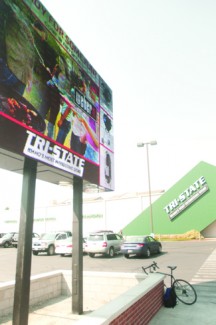Prompted by the recent influx of large, electronic signs, the City of Moscow Planning and Zoning Commission may enact an emergency ordinance that would set standards for these signs.

Philip Vukelich | Argonaut
A newly installed Tri-State electronic sign is one of a few that prompted the City of Moscow Planning and Zoning Comission to develop standards for future signs.
“The Planning and Zoning Commission discussed the topic in the beginning of June,” said Bill Belknap, community development director. “They drafted their concerns to see how the commission would like to proceed. Tonight (Monday) the committee will receive that letter. It was presented to the administration committee last week.”
In the letter submitted to the City Council, the Planning and Zoning Commission said, “The Commission is seeking the City Council’s guidance on this topic and request that the Council provide the Commission direction to develop an amendment to the City’s Sign Code and the desired objectives of such an amendment.”

The Planning and Zoning Commission said that the City’s options are to either prohibit the signs or establish standards for future signs.
Belknap said the administration committee seemed to indicate interest in developing standards for these signs, but the Planning and Zoning Commission will determine if these standards will be enacted through regular procedures or through an emergency ordinance.
“If we enact an emergency ordinance it is no longer than 180 days,” Belknap said. “An ordinance typically takes between three to six months, so the concern is that once we begin to talk about it there will be a rush to get under the current system.”
Belknap said when the commission meets to determine which route to take, they have to determine if the issue meets the requirements for an emergency ordinance.
This means, “an imminent peril to the public health, safety, or welfare requires the passage of an emergency ordinance,” according to the city code.
Belknap said there are two main concerns that the commission claimed justified the ordinance.
“First, there is an aesthetic concern for the community. They may be fairly large, bright at night and may result in visual clutter,” Belknap said. “The second concern is the distraction of drivers. The signs are designed to attract attention, so the concern is in motorist safety.”
The current sign code allows internal or external illumination
restricts the use of strobe lights, beacons and flashing lights, but provides no standard for LED or other internally lit signs.
In determining a proposal, the Planning and Zoning Commission looked at 13 other cities’ sign codes, including Lewiston, Meridian, Pullman and Spokane. They found that seven allow dynamic display signs, while six prohibit them entirely. Those that allow them regulate size, brightness and dynamic elements like animation.
Katy Sword can be reached at [email protected]
